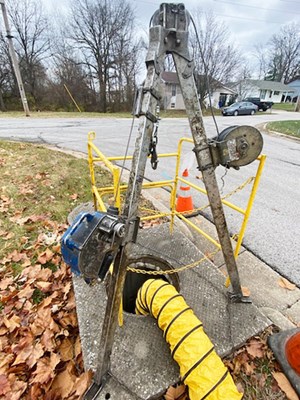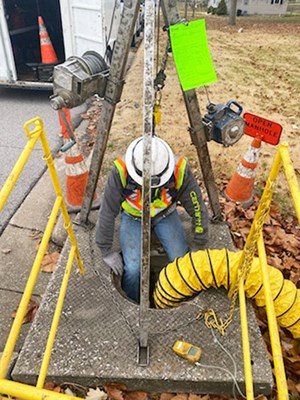January 2024 Vol. 79 No. 1
Features
Navigating, understanding hidden dangers of permit-required confined space entry
By Dennis Pivin, CSP, NASSCO Director of Health, Safety and Environmental
There are many occupations that require the safe performance of work when confined space is involved.
This includes, but is not limited to, sewer structure rehabilitation, manhole entry and infrastructure inspection processes. Any incidents or accidents during confined space entry are of particular concern to health and safety, due to the hazards they pose to the potential victim or entrant, as well as the attendant and rescue team.
Understanding these hidden dangers, and the critical importance of proper preparedness in confined space, are vital to a safe work site.
To begin, we need to understand the definition of confined space. According to the Occupational Safety and Health Administration (OSHA), a permit-required confined space is generally one that:
- Has limited or restricted means of entry or egress
- Is large enough for a person to enter to perform work
- Is not designed for continuous occupancy
- Contains, or potentially contains, a hazardous atmosphere
- Has the potential for engulfing the entrant
- Designed in a manner that could cause an entrant to be trapped
For the purpose of this article, we will assume that all sewer structure rehabilitation entries will be considered a permit-required confined space entry due to the possibility of the above conditions existing at any given time.
In 2015, OSHA enacted the revised Construction Confined Space Standard under 29 CFR Part 1926. We will mention a few items under this standard, before discussing the critical items for confined space.
Written program
Keep in mind that prior to working in sewer structure access points, each employer must have a written program that includes the following:
- Identify all confined spaces. For example, sewer structure access points consist of manholes, pits, sanitary manholes, storm sewer manholes, lift or pumping stations, catch basins, culverts and grease traps.
- Evaluate confined spaces for hazards.
- Establish protection procedures for controlling hazards.
- Set up confined space permit procedures for entering the space.
Once the written plan is in place, you may still need to cover some items. First, when preparing to enter a sewer structure access point, it should always be considered a permit required entry.
Second, whenever workers have any part of their body in the confined space, they are technically considered entering the confined space and must follow all aspects of the standard.
Third, after opening manhole covers and access lids, the opening should be promptly guarded to prevent an accidental fall through the opening. Never leave an open manhole unguarded or unattended.
Finally, a sign is needed onsite of the confined space entry. It should warn workers and the public of the hazards, with language like, “Danger – Permit Required Confined Space – Do Not Enter.”
Some key elements of the standard are designed to protect workers from unknown hazards and potential injury. These include continuous air monitoring, continuous ventilation, completion of a confined space permit, entrants wearing a properly fitted harness and being attached to a winch retrieval system and self-retracting lifeline.
Following is a brief breakdown of these critical components:
Continuous air monitoring or atmospheric testing
Before an employee enters the space, the entire internal atmosphere shall be tested – all levels (top, middle and bottom). Gases in confined spaces have different densities and may be found in varied locations within the confined space. Typically, the sewer rehabilitation industry will include sensors for the following: oxygen, LEL, hydrogen sulfide and carbon monoxide.
The atmosphere within the confined space must be continuously monitored. The employer must ensure that the monitoring equipment has an alarm that will notify both attendants and entrants if a specified atmospheric threshold is exceeded. In addition, air monitors must be calibrated, and bump tested at a minimum, per the manufacturer’s specification.
Continuous ventilation
After the initial air sampling has occurred, start the ventilation process but always continue air monitoring.
Pay close attention to the location of the blower intake. Typically, manholes or entry points are in streets, and near traffic and construction vehicles. Always ensure that the blower intake fan is located away from running vehicles. Failure to focus on blower location may result in moving unwanted toxic gases, like carbon monoxide, into the confined space where they may not have been originally.
Prior to entering the confined space, a confined space permit must be completed
The employer determines the employees qualified for these roles.
Key elements required on the confined space permit include, but are not limited to:
- Date and authorized duration of the entry
- Name of the authorized attendant
- Identity of authorized entrants inside the permit space (i.e., rosters or tracking systems)
- Logging of air-monitoring results at regular intervals, as determined by the employer
- Identifying hazards associated with the confined-space entry
Upon completion of the confined space entry, the permit must be signed and closed to ensure completion by the entry supervisor.
Entrants must wear a properly fitted harness
When entering a confined space, the entrant must wear a harness for both retrieval and fall protection.
Harnesses should be inspected before use. Always follow the harnesses’ manufacturing specifications for all training and inspection protocol.
Entrants must be attached to a retrieval winch and fall protection device
When the entrant is being lowered into a sewer structure access point, the person must be attached to a self- retracting lifeline (SRL) to prevent a fall, as well as be attached to a retrieval winch/lifeline system.
The entrant must remain attached to this system the entire time the worker is in the confined space.
Confined space training
Lastly, all confined space workers must be trained per the OSHA 1926 Construction Confined Space Standard. This training must include informing workers about the existence and location of, and dangers posed by, each permit-required confined space.
Employers must train workers involved in permit-required confined space operations so that they can perform their duties safely and understand the hazards in permit spaces, and the methods used to isolate, control, or protect workers.
Effective training is essential and creates a safety-first mindset for workers in confined space. Some key aspects include:
- Review all company confined-space procedures
- Cover proper use of all confined-space equipment
- Review all company polices for first aid and emergency response
- Know how to inspect sewer structures and systems to identify unique hazards
- Cover all use and handling of company issued monitoring equipment
- Cover all use of company issued ventilation systems
- Detailed understanding of the company confined-space permit and how it should be completed and saved.
Final thoughts
The standard provides the user with the information and tools needed to successfully implement a safety-confined space program.
A complaint program involves understanding what “confined space” is in the workplace. It also requires having a written assessment of the hazards that may be present and listed on the confined space permit, the systems to be used to monitor for and eliminate the hazards (air monitoring, ventilation, retrieval systems, fall protection, hazardous energy control), employee training to use all the systems required by the employer and, lastly, procedures for responding to an emergency.
In closing, there will be an opportunity for anyone working in or managing sewer structure rehabilitation, manhole entry and infrastructure inspection processes to attend a hands-on confined space training course at the upcoming UIC conference. To register and join us in learning the latest techniques and technology for safe confined space entry, go to ui-conference.com.
To learn more about safety topics, please visit www.nassco.org/safety/







Comments